BUTTERFLIES & PLANTS I
Below is a portion of our butterfly and hummingbird garden, followed by some of the 127 kinds of butterflies that have occurred in the yard. Whenever possible, host or nectar plants are included.

Karen starting a section of our butterfly garden (13 December 2003). Killing and removing all that Bermuda grass was the first step.

The same spot as above after many visits to Cochise Stone for the gravel (the rocks we landscape with are from the property), and plant sales at Desert Survivors, the Arizona Sonora Desert Museum, Tohono Chul Park, and some plant trading with friends (15 September 2005).

Same spot as above with snow (22 January 2007). Nothing seemed to suffer unduly.

Another part of the garden (20 August 2006).

Award winning writer and lepidopterist Robert Pyle (left) visited our garden during his butterfly big year documented in Mariposa Road: The First Butterfly Big Year (1 Oct 2008) (Photo by Karen LeMay).

Broad-banded Swallowtail has occurred in Arizona about 15 times. This male of the subspecies bajaensis (above and below) was nectaring on verbena where its bouncy flight and refusal to pose made for difficult photography (9 July 2009).


On 1 August 2010, a second male Broad-banded Swallowtail visited the yard. Note, both nectared on the same species of verbena.

Now the rarest butterfly that's visited the yard, this Polydamas Swallowtail was the second Arizona record. It nectars here on Butterfly Milkweed Asclepias tuberosa (6 August 2007).
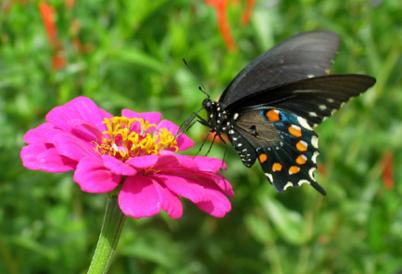
Pipevine Swallowtails are common local breeders whose caterpillars feed on the Pipevine growing in the yard . This one is nectaring on Zinnia (23 August 2005).

A Pipevine Swallowtail caterpillar (23 March 2009).

A very early Two-tailed Swallowtail feeds on Penstemon eatoni (16 February 2006).
 |  |
A Two-tailed Swallowtail caterpillar on Arizona Ash. This instar resembles a wet bird dropping (17 August 2008). | The same caterpillar two days later. This later instar has false eye spots that resemble snake eyes (19 August 2008) . |
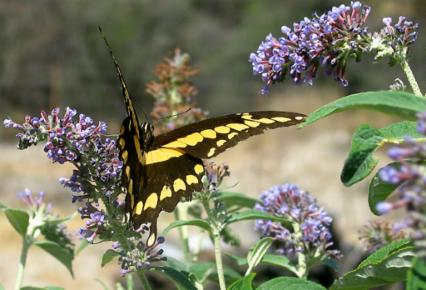
A Giant Swallowtail nectars on Buddleia davidii, the classic butterfly plant (Karen LeMay photo) (26 June 2006). Ultimately, we pulled this plant as it required nearly constant dead heading (pruning) and a fair amount of water.

A worn male Black Swallowtail flits between Lantana blossoms (24 July 2006).
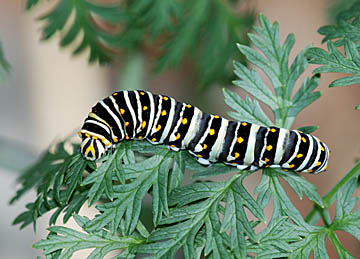
A Black Swallowtail caterpillar (11 September 2009).

Karen got a distant shot of this very rare light-morph Black Swallowtail as it blasted through our garden (3 August 2020). Thanks to Bailowitz and Brock for the id., which was puzzling.

A fresh chrysalis of a Black Swallowtail (1 August 2010).

Yellow Angled-Sulphur is a very rare butterfly in Arizona. Karen found this one as she looked out the kitchen window (23 Oct 2016). It nectared on lantana then roosted in our fig tree. The next day, it was gone. It was the 20th pierid for the yard!

The monsoon season always brings surprises. This Florida White (Appias drusilla), a species recorded in Arizona approximately 10 times (per Rich Bailowitz), appeared on our trusty lantana (23 August 2010).
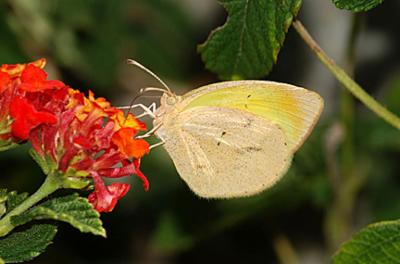
This Barred Yellow nectaring on Lantana was species #100 for the yard (28 October 2007). A second one was photographed 14 November 2015.

Boisduval's Yellow is a sparse visitor from Mexico (rarely breeding). Here, one nectars on Tithonia (9 October 2007).

A decidedly rare Mimosa Yellow was present in the garden for several days during November 2015 (7 November). That week also produced Barred and Boisduval's yellows!
 |  |
Orange-barred Sulphur, a low density Mexican influx species, nectars at Zauschneria, sometimes called Hummingbird trumpets (L) and Scarlet spires Salvia (R) (8 Oct 2006).

Owing to their rarity in SE Arizona, we were surprised to see a number of these caterpillars of Orange-barred Sulphur feeding among caterpillars of Cloudless Sulphur on a Canyon Senna shrub (9 August 2015).
 |  |
Cloudless Sulphur nectaring on Aster (24 September 2005) (L); Southern Dogface nectaring on Cosmos (5 November 2005) (R).
 |  |
A Cloudless Sulphur caterpillar feeding on Senna (2 Sep 2005) (L); this Southern Dogface caterpillar is feeding on Dalea bicolor (9 June 2005) (R).

A Cloudless Sulphur's beautiful chrysalis (10 September 2006).

A Pearly Marble rests on Blue Dicks (Dichelostemma capitatum) (24 Mar 2005).

A Large Orange Sulphur nectars on Lantana (6 August 2006).
 | 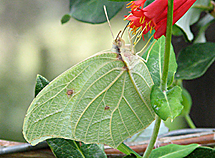 |
A locally uncommon and late White Angled-Sulphur feeds at a butterfly feeder (19 Dec 2003) (L); another nectars on honeysuckle (Lonicera sempervirens) (25 August 2007) (R).

A Sleepy Orange nectaring on Salvia serpyllifolia (3 Nov 2005).

The dorsal wing surface of a Tailed Orange caught by a crab spider on Salvia reptens (13 September 2006),

Tailed Oranges nectaring on Blanketflower (Galliardia) (30 October 2006).

Dry or winter form (L) and wet or summer form (R) of Tailed Oranges nectaring together on Tithonia (28 September 2008).

A Tailed Orange caterpillar feeding on Sensitive partridge pea (Chamaecrista nictitans) growing in the driveway (20 October 2014).
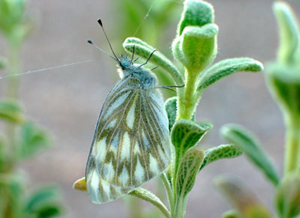
This Checkered White is resting on Jerusalem Sage (12 March 2005).
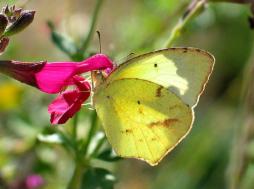
Mexican Yellow, a common monsoon species that persists into winter, here nectaring on Salvia serpyllifolia (7 Nov 2005).
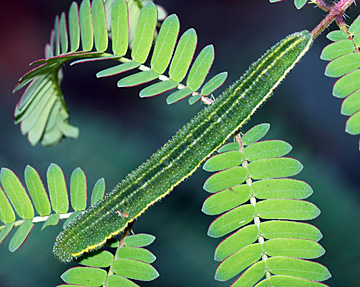
A caterpillar of Mexican Yellow on its host plant: Fern or Prairie Acacia (25 August 2008).

Cabbage White, an introduced and decidedly uncommon visitor to the yard, nectaring on Catmint (8 Nov 2005).
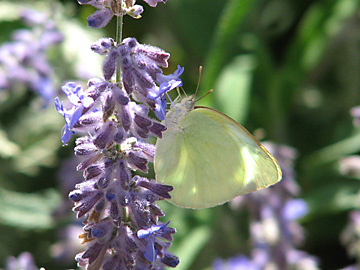
One of at least 30 Lyside Sulphurs that suddenly appeared and were nectaring on this Russian Sage (6 August 2006).

Dainty Sulphur, a species present much of the year, nectars on Pink Chintz Thyme, an ornamental ground cover (5 October 2006).
 |  |
Orange Sulphur on Salvia leucantha (2 November 2006) (L); and a dorsal shot of another (1 October 2006) (R).

A caterpillar of Orange Sulphur found by Karen when she was weeding. As it was on grass, it may have been roaming to find a site for pupation (27 September 2014).
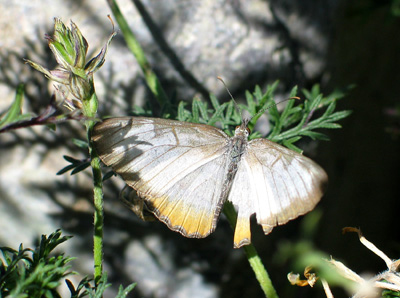
Common Mestra has occurred twice in our yard. This one suns on verbena (19 Nov 2005). Another was present on 1 December 2012.

After 18 years, we had our first Zebra (Longwing) Heliconian, a locally rare visitor from Mexico (5 September 2021).
 | 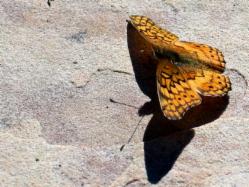 |
A melanic Mexican Fritillary basking on gravel (18 Nov 2005) (L): Variegated Fritillary basking on flagstone (19 Nov 2005) (Karen LeMay photo) (R).
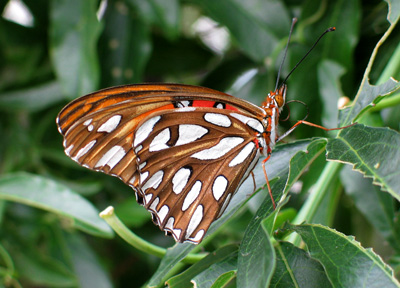
Gulf Fritillary on Passionflower Vine (19 September 2005).

Gulf Fritillary caterpillar on Passionflower Vine (its host plant) (16 September 2004).
 |  |
A Painted Lady feeding on banana goop (15 Dec 2004) (L), and another nectaring on Buddleia (25 July 2005) (R).
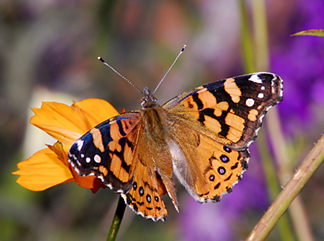
A West Coast Lady, a sparse visitor here, nectars on Cosmos (31 October 2006).

American Ladies were numerous on Coneflower (Echinacea) during early morning when this shot was taken (2 July 2007).
 |  |
A Dark (Tropical) Buckeye nectars on Vitex (28 September 2008).

Caterpillars of Bordered Patch (Chlosyne lacinia) above and below on leaves of Tithonia--one of a number of sunflowers this species uses. (29 September 2012).


A fresh Bordered Patch chrysalis attached to a step stool on our porch. Note the final caterpillar skin still adhering to the chrysalis (24 August 2014). See below.

A Bordered Patch emerges from the above chrysalis as well as another from an adjacent chrysalis six days later (30 August 2014).

Bordered Patches generally appear with the monsoons, often in great numbers. This one is nectaring on Buddleia (24 July 2006).

This Arizona Sister basks on a grassy area just after probing the mud at the edge of our pond (11 May 2007). See http://www.utahlepsociety.org/adelphabredowi.html for tips on separating Arizona Sister from the very similar California Sister.

A male Queen nectaring on Cosmos (2 Sep 2005).

This Queen caterpillar has assumed the classic J posture and is ready to form its chrysalis (see below) (20 July 2008).

Just a few minutes later, the last larval skin has been shed (see it bunched up on the left), and the jewel-like chrysalis is formed.

This female Monarch nectars on Buddleia (25 July 2006).
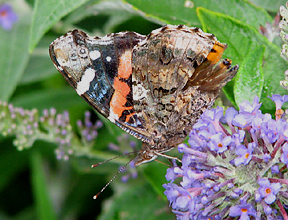
A tattered Red Admiral nectars on Buddleia (7 August 2007). Both Red Admirals and Mourning Cloaks are attracted to our overripe figs.
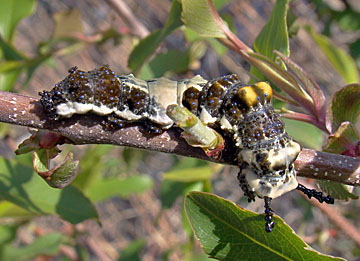
Adult Red-spotted (Purple) Admirals are infrequent visitors to the yard, usually flying in the higher canyons. However, their bird-dropping-like caterpillars may be seen if you look on their host plant. Here one feeds on cherry (26 March 2012).

A surprise away from its usual riparian haunts, this Viceroy basks on a leaf of our fig tree (3 September 2007).

Another unexpected guest: this Empress Leilia, more common at lower elevations with Hackberry trees or shrubs, suns on rocks adjacent to the pond (26 September 2008).

This Hackberry Emperor, originally attracted to an orange put out for orioles, was butterfly #119 for the yard (16 July 2017).
Jump to Butterflies & Plants II
Jump to Butterflies and Plants III
Jump to Some Yard Moths

Robert A. Behrstock 2021
Images may not be reproduced without the Photographer's permission.